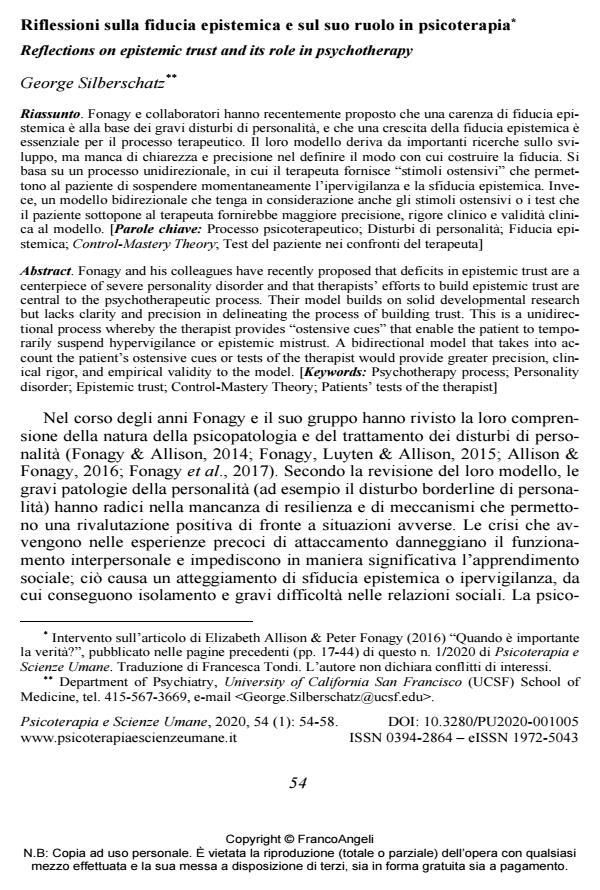Riflessioni sulla fiducia epistemica e sul suo ruolo in psicoterapia
Titolo Rivista PSICOTERAPIA E SCIENZE UMANE
Autori/Curatori George Silberschatz
Anno di pubblicazione 2020 Fascicolo 2020/1
Lingua Italiano Numero pagine 5 P. 54-58 Dimensione file 76 KB
DOI 10.3280/PU2020-001005
Il DOI è il codice a barre della proprietà intellettuale: per saperne di più
clicca qui
Qui sotto puoi vedere in anteprima la prima pagina di questo articolo.
Se questo articolo ti interessa, lo puoi acquistare (e scaricare in formato pdf) seguendo le facili indicazioni per acquistare il download credit. Acquista Download Credits per scaricare questo Articolo in formato PDF

FrancoAngeli è membro della Publishers International Linking Association, Inc (PILA)associazione indipendente e non profit per facilitare (attraverso i servizi tecnologici implementati da CrossRef.org) l’accesso degli studiosi ai contenuti digitali nelle pubblicazioni professionali e scientifiche
Fonagy e collaboratori hanno recentemente proposto che una carenza di fiducia epistemica è alla base dei gravi disturbi di personalità, e che una crescita della fiducia epistemica è essenziale per il processo terapeutico. Il loro modello deriva da importanti ricerche sullo sviluppo, ma manca di chiarezza e precisione nel definire il modo con cui costruire la fiducia. Si basa su un processo unidirezionale, in cui il terapeuta fornisce "stimoli ostensivi" che permettono al paziente di sospendere momentaneamente l’ipervigilanza e la sfiducia epistemica. Invece, un modello bidirezio-nale che tenga in considerazione anche gli stimoli ostensivi o i test che il paziente sottopone al terapeuta fornirebbe maggiore precisione, rigore clinico e validità clinica al modello.
Parole chiave:Processo psicoterapeutico; Disturbi di personalità; Fiducia epistemica; Control-Mastery Theory; Test del paziente nei confronti del terapeuta
- Risposta agli interventi di Morris N. Eagle, Mauro Fornaro e George Silberschatz Elisabeth Allison, Peter Fonagy, in PSICOTERAPIA E SCIENZE UMANE 1/2020 pp.59
DOI: 10.3280/PU2020-001006 - Online psychological support in the COVID‐19 era: Social representations, trust and perceived effectiveness from the perspectives of clients and professionals Elisa Colì, Loredana Gavrila, Dacia Cozzo, Rino Falcone, in Counselling and Psychotherapy Research /2024 pp.1415
DOI: 10.1002/capr.12779
George Silberschatz, Riflessioni sulla fiducia epistemica e sul suo ruolo in psicoterapia in "PSICOTERAPIA E SCIENZE UMANE" 1/2020, pp 54-58, DOI: 10.3280/PU2020-001005